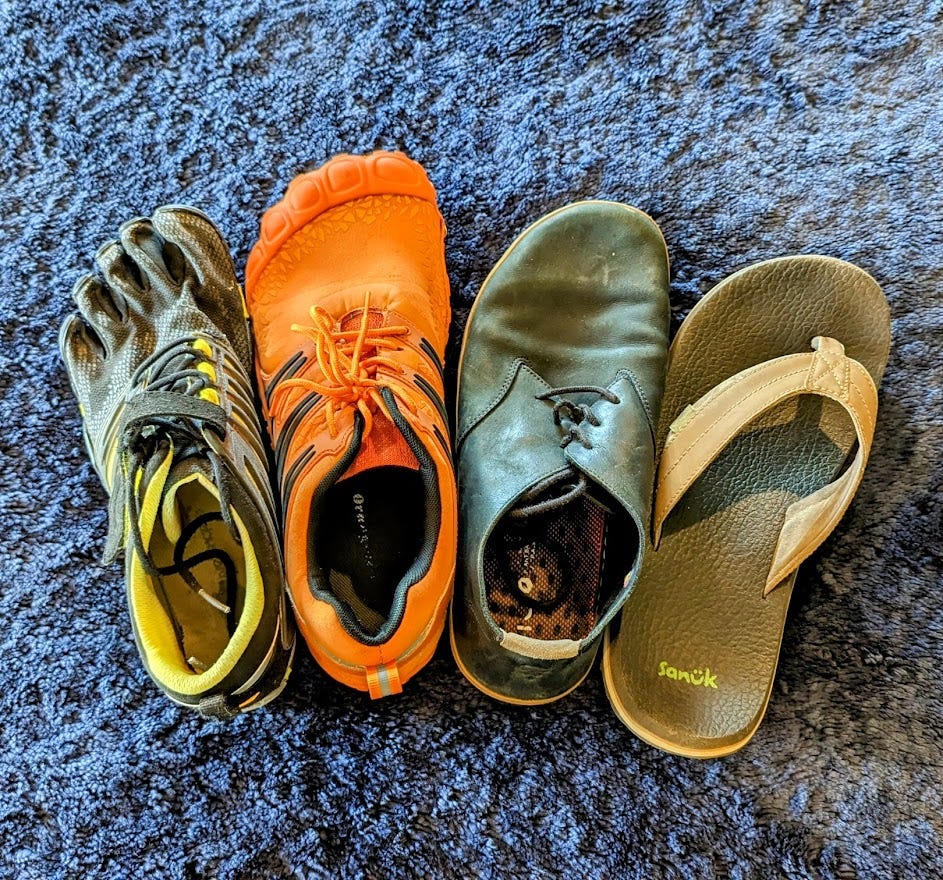We Walk Wrong
Part 2 in: A Trifecta of Poor Biomechanics
Welcome to Polymathic Being, a place to explore counterintuitive insights across multiple domains. These essays take common topics and investigate them from different perspectives and disciplines to come up with unique insights and solutions.
Today's topic is an exploration of poor biomechanics and tackles the way we walk and run. I’ll admit, I fell victim to the ideas of running promoted by shoe companies and suffered the consequences in my age. We already covered how we breathe wrong and so this essay will explore walking and share my experiences with how I’ve solved it and the benefits that are provided.
Before we start, this is a three-part series and were originally for paid subscribers as an extra thank you for their support. I’ve opened them up for everyone but your support is still critical. Please sign up for 20% off for an annual subscription making it just $24.
Part 1: We Breathe Wrong:
Part 3: We Poop Wrong:
We Walk Wrong
Introduction
Biomechanics are an interesting topic especially when analyzed against our evolutionary development and their collision with modern technology. What we find as we peel back our generally accepted lifestyles are that there are things we do every day in life that are, by and large, wrong.
Not just wrong but actually quite damaging to our ability to be active, healthy, and well-aged. It might surprise you, but we breathe wrong, and we walk wrong again, mostly thanks to technology.
Walking Wrong
Walking wrong isn’t a new surprise for me after extensively studying the biomechanics of running when Vibram Five Fingers first hit the market. I bought my first pair in 2008, and never went back.
I quickly realized the benefits of the minimalist style when the degenerating disks in my lumbar, which threatened to stop my running forever, were no longer aggravated by the impact. I vividly remember walking up and down a hallway as an officer in the Army and then, at lunch, I swapped out to my Five Fingers for a workout.
As I walked down the same hallway again I was shocked at how hard my feet were hitting the ground. But that wasn’t because I was walking heavier, it’s because the boots had been distributing the force and with the minimalist Five Fingers. I was still hitting with as much impact, I was just feeling it focused on my heel.
It reminded me of a time earlier in my Army career when I was in a boxing gym. I’d been using the heavy bag with just hand wraps for a few weeks and my trainer had me put 16oz gloves on. I felt great. My trainer came back after a much shorter duration than normal and told me to call it quits. I complained that I felt great. He told me to let him know how I felt in the morning.
I felt so sore the next morning! My wrists, elbows, and shoulders all hurt. He laughed when I came back and told him. When I asked why I hurt so badly he shared that the glove isn’t softer, it just distributes the force. Since your body expects certain level of sensory feedback, you hit harder and that force is transferred into your arms
The same was true for my walking. To maintain balance your body demands a certain level of impact to register and adjust. When we wear thick heels, we ‘blind’ our body and end up impacting harder. Yet the impact still travels up into your knees, hips and back even though the precise impact is distributed and masked. Just like punching a bag with bare hands has more feedback than punching with thick gloves.
In 2011 Christopher McDougall released the entertaining book Born to Run which addresses this phenomenon as well as other incredibly damaging effects of modern shoes to the general consciousness.
The irony here, is that we haven’t had the luxury of modern footwear until, fundamentally, the 1980s! From then on it just became a competition to out engineer our feet and yet failing with incredibly catastrophic results.
I look back and I’m a bit chagrined because I dutifully taught the heel strike technique for running for many years. It was so accepted, and I’d never heard an alternative. It still surprises me how fast we ignored nature, and the heel-strike became the preferred, and yet dangerous style of running.
The Power of Nature
The human foot is a work of art and a masterpiece of engineering.
- Leonardo Da Vinci
Our feet are masterful and contain two arches, one front to back, and the other side to side. These arches work together with the tendons to absorb and return energy while running. When you consider the entire system of the ankle, Achilles tendon, and calf muscle you’ve got such an amazing energy capture and return mechanism it’s absolutely shocking we think heel striking is OK.
Because heel striking is not OK! In fact, by eliminating all the mechanics of the ankle-down you now take all of the impact, and instead of absorbing, it gets pushed straight into the knees, hips, and back. Studies have shown that heel striking leads to double your body weight in impact, whereas forefoot, or midfoot striking can reduce the impact to 80% of your body weight.
Another nice side effect of not heel striking is that it becomes almost impossible to twist your ankle while running. There are just too many degrees of freedom for that to happen anymore. I had a friend who suffered multiple bad sprains and switched to forefoot running and never sprained their ankle again. (it’s been ten years now). The same goes for hiking and the benefit is you don’t have to wear heavy boots to avoid twists because, even under weight, a midfoot strike prevents that.
Walking, which is more efficient as heel-toe for humans, has the same problems because our standard shoes transfer too much energy to our heels causing similar impact issues. Over the years, I’ve replaced all my shoes with minimalist offerings:
Five Fingers for running and exercising
V-Treks for backpacking
Vivo Barefoot for dress shoes
Sanuk sandals for everything else
For me, it’s made an incredible difference in reducing knee and back pain and it has kept my back injury from getting worse. It’s also been interesting watching my feet widen, strengthen, and feel better. No chance of bunions for me!
This doesn’t even get into the catastrophe of shoe designs with narrow toe boxes or those horrifically terrible high heels that destroy women’s’ knees, hips and backs for the sake of style. (You know what’s stylish? Not hobbling when you’re 40 because your feet are a broken mess).

The path we took to get to the point we walk wrong is simple: We believed technology could do better than nature. We now have shoes to correct all sorts of foot issues that actually make things worse. Arch support causes the collapsing of arches the same way a cast causes a broken arm to atrophy; if you no longer have to support the weight, your body won’t.
What to Do
To those that are ready to go grab a pair of minimalist shoes and head out, a word of caution. Just like you wouldn’t run a marathon without training so too should you not jump into minimalist without training.
I made that mistake when I went on my first run in Five Fingers. I went 5 miles and couldn’t walk the next day.
You also can’t continue to run and walk the same way. You have to change to a mid-foot strike, or you’ll continue to harm your heels. While you can shift your form with regular shoes, minimalist will give you faster feedback with less cheating.
You also need to allow your feet to rehabilitate and strengthen. Work into it over the course of hours and days and weeks. It will take time to rebuild your foot and calf strength to regain your full potential.
But also, don’t do like my friend who knew all the science, wrote a research paper on the topic validating the forefoot strike and yet wouldn’t change themselves because they didn’t want to ‘start-over’ yet constantly experienced pain while running. It will take a reset, but it’s a reset you need.
The interesting aspect with walking is that, like breathing, it’s a function of our modern technology that ignores eons of evolutionary development and biomechanics. We breath wrong, we walk wrong, and there’s one last thing we do wrong that we’ll cover next week.
This essay wass exclusive for paid subscribers. I recently opened it to everyone but please consider supporting Polymathic Being financially so we can keep these open for everyone. Stay tuned next this week for Part 3: You Poop Wrong. That one is also for paid subscribers.
Enjoyed this post? Hit the ❤️ button above or below because it helps more people discover Substacks like this one and that’s a great thing. Also please share here or in your network to help us grow.
Polymathic Being is a reader-supported publication. To receive new posts and support my work, consider becoming a free or paid subscriber.










One interesting thing about jiu jitsu and judo is being barefoot all the time. I'm not comfortable walking around anyone's home with shoes on (not to mention, hygiene!), largely because I really like to feel the floor underneath my feet. I don't run now, but I do go for walks every day, and I walk with Crocs. They seem to do a good job of supporting my foot without playing any shenanigans with my posture or lower back, but I'd always prefer to be barefoot indoors.
I see you continue to ruin every daily activity for me!
I run three times a week, and until now never even had to think about whether I was heel striking, ankle gliding, or toe tapping. Down the rabbit hole of research I go!